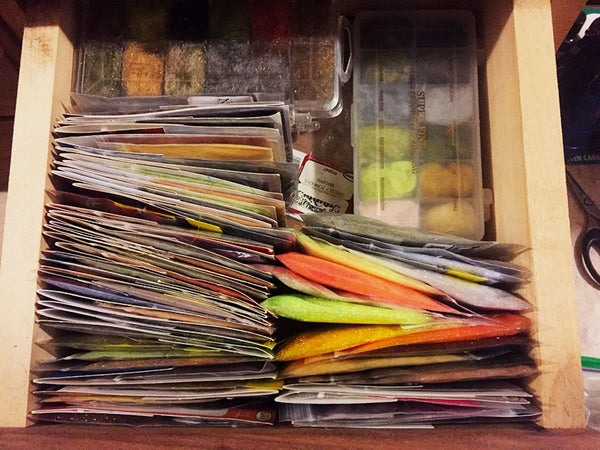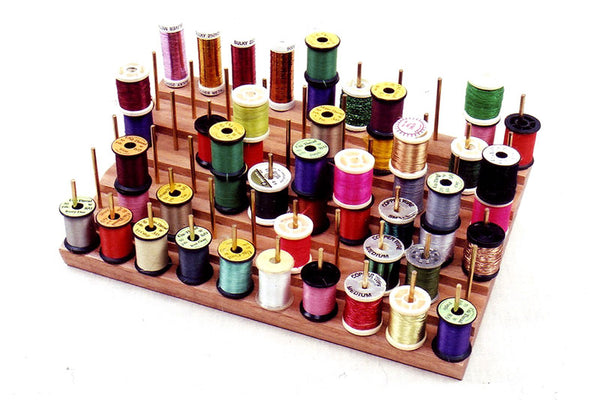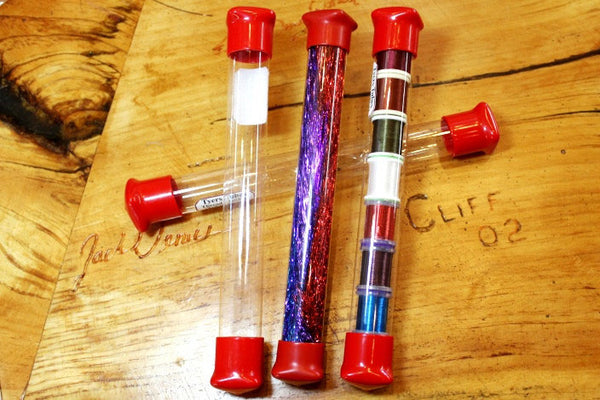Where the Heck Is My Bobbin? The Messy Fly Tyer’s Guide To Organizing Fly Tying Materials


Jared Koenigsfeld of Driftless On The Fly's tying desk.
We’ve All Experienced the Frustration of Not Being Able To Find a Material You Need While Fly Tying
I'm probably one of the least organized people on the planet, but recently my custom fly tying business was getting busier and busier and tying was taking me longer than it should've due to me losing materials in what I used to call my "organized chaos."
We all know what that means...
The main sources of my problem were me not putting materials and tools away when I was finished with them, shoving them in random drawers, or simply never putting them away when I brought them home.
Although I barely own any storage items specifically designed for fly fishing or tying, there are a few I've used to help my problem and recommend to everyone to make your fly tying more fun and less frustrating.
Hook and Bead Boxes
Almost every fly is built off of a combination of a hook and a head, so keeping these base materials well organized provides major time savings.
I prefer the Meiho brand of hook and bead boxes. These solidly built boxes have tight-locking lids and dividers that prevent even the smallest hooks from crossing over to the other slots and allow them to travel extremely well.
All my nymph hooks are stored together in one box, dry fly hooks are in one box, and bass and saltwater hooks are combined in one box.
Fly Fishing Hacks: How to Not Forget Anything on Your Next Fishing Trip
I also have boxes for lead eyes, Fish-Skull Baitfish Heads, bead chain eyes, and a separate box for bead heads and cone heads.
Labeling each box and individual compartments within them helps with quickly finding the materials you need.
Thread Rack
This is one of the few times I actually use an organizational item meant for fly tying – the Oasis thread rack.
5 Proven Tips to Help You Tie More Flies
This rack keeps all my thread visible and easy to get to when needed and has the added benefit of being able to store anything else that is spooled on it as well.
Tubes With Removable Ends
Dan Bailey's Tyer Tubes are handy for storing krystal flash and flashabou.
These are available from Dan Bailey’s Fly Shop or from Kelly Galloup's Slide Inn.
Tricks of the Fly Tying Trade: 3 Everyday Objects to Boost Your Tying Productivity
Dan Bailey offers these in sizes for flash, thread, ostrich, and peacock, as well as pheasant tails.
I prefer to just use the flash size; I have other options for thread and feathers.
Ziploc Bags

I store all like materials together in Ziploc bags, in their original packaging.
This allows me to grab one bag of Marabou (for example) and know that all my colors are there and they are being controlled and confined to the bag. This also considerably compresses storage.
Rubbermaid Totes / Drawers

My dubbing drawer.
Rubbermaid totes are a good option for storing deer hair and hackle.
I keep my materials in the original bags and then place them in something a little bigger, such as totes or drawers. I built wooden drawers for this purpose; however, the fairly cheap plastic sets work just as well.
My drawers include:
- Zonkers and small strips/patches of fur.
- Small feather packs (marabou, strung hackle, peacock herl, CDC).
- Large pelts (squirrel, hare's mask, buck tails).
- Synthetic body material (craft fur, Body Tubing, chenille).
- Foam, rubber legs, flash, and eyes (foam and accents).
- Dubbing.
- Popper bodies.
- Extra deer hair.
All of these items are bagged individually, then stored in larger bags with variations of the same type of material (marabou in a marabou bag, etc.).
Get Started!
Now, I know you're thinking, “Man, that's going to take a while.”
Yes, it will take a little while to start, but once you tackle it and stay on top of it, your tying will improve, be more enjoyable, and you'll turn out flies faster.
Happy tying!
Want More Articles Like This?
Subscribe to the Flymen Mailing List at the Bottom Right of the Page!
About Lee Blanton:
 Lee (@lee.blanton_1981) grew up in North Alabama fishing the not-so-famed Wills Creek, as well as the Smokey Mountains of Tennessee. He first grabbed a fly rod at the ripe old age of 11 and soon began tying flies for any innocent sunfish or bass that would fall for the trick. This continued on through high school where he began performing aquatic entomology assessments on local streams which further drummed up his knowledge on aquatic insects, and how to imitate them with flies.
Lee (@lee.blanton_1981) grew up in North Alabama fishing the not-so-famed Wills Creek, as well as the Smokey Mountains of Tennessee. He first grabbed a fly rod at the ripe old age of 11 and soon began tying flies for any innocent sunfish or bass that would fall for the trick. This continued on through high school where he began performing aquatic entomology assessments on local streams which further drummed up his knowledge on aquatic insects, and how to imitate them with flies.
He currently resides in Weatherford, TX, just outside of Fort Worth, where he teaches high school and has his own custom fly tying business Wills Creek Fly Fishing, specializing in warm-water flies. Lee has designed a fly that has set three Texas fly rod records for Green Sunfish, one which measured a massive 13.25 inches in length. You can contact Lee via his website www.willscreekflyfishing.com or email lee@willscreekflyfishing.com.





Please enroll me.
I just inherited five boxes of fly tying gear. Two large boxes of feathers and one medium box of furs. Then an entire
sewing box of yards, threads, and tying tools. There is another box of hooks and two organizer trays of hooks and beads. How is the easiest way to organize the feathers and fur?
I just inherited five boxes of fly tying gear. Two large boxes of feathers and one medium box of furs. Then an entire
sewing box of yards, threads, and tying tools. There is another box of hooks and two organizer trays of hooks and beads. How is the easiest way to organize the feathers and fur?
Making space is my biggest challenge.Gotta work on it. Takes too much time from fishing!
Got your blog by accident or on purpose, not sure. In either event I liked what I saw.
I am in process of writing a small paperback hand book hopefully to be published late 2017. In the meantime I would like to send you occassionally some tips I learned over the years on fly tying, wood carving, metal working, repairing old screws, etc. I am a retired line chief from Army aviation. (Why jump or repell or hike when you can fly!) I also retired from gunsmithing for some 12 or 14 Europen gan makers as factory authorized repair facility. I retired from automotive service industry. And the one I had most fun with other than gunsmithing was, Amer & Euro small engine repair 2 stroke and 4 stroke. So let me know if you are interested in my little contributions. Later, Frank in Florida.
Leave a comment